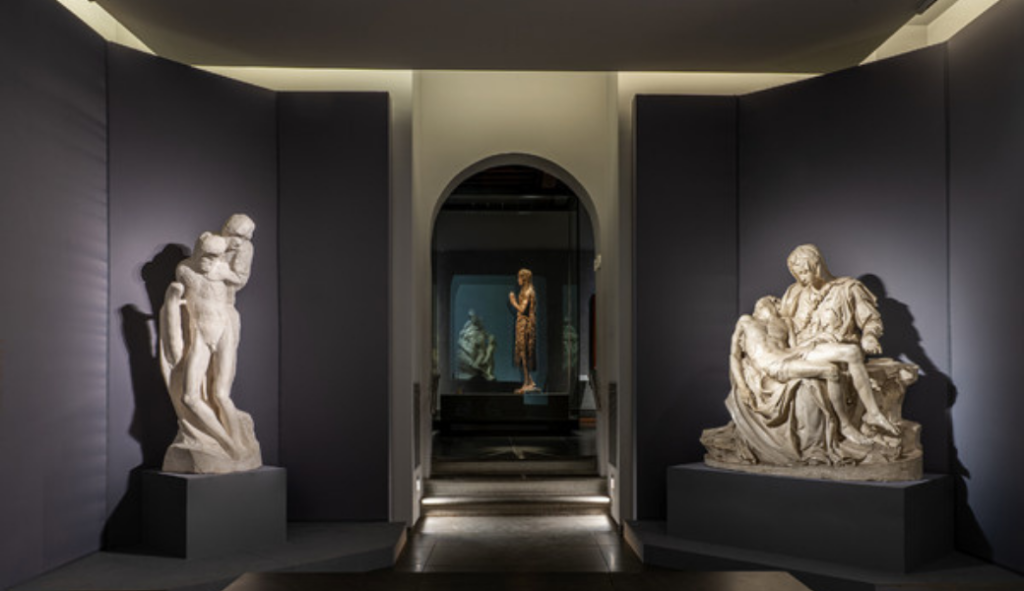For the first time, an exhibition compares the three Pietà of Michelangelo. One next to the other, the original of the Bandini Pietà, which has just been restored, encounters the casts of the Vatican Pietà and the Rondanini Pietà from the Vatican Museums.
The three statues are in exhibition at the Michelangelo’s Tribune room of the Museo dell’Opera del Duomo. Together, they offer the public the opportunity to see the evolution of Michelangelo’s art as well as his spiritual maturation, from his early youth – when in Rome he sculpted for the Chapel of the Kings of France in ancient San Pietro (the work is now in the north side aisle of the Basilica) – to his last season, when, now old, he put his hand to the to the Pietà today in Florence and then to the Pietà Rondanini preserved in Milan.
It is a journey of more than fifty years, which ranges from the ambition of the young man who carved his name on the Madonna’s chest in the Vatican version, to the personal identification of the elderly artist, who in the Opera Museum portrays himself in the likeness of Nicodemus.
Near his death, Michelangelo meditated deeply on the Passion of Christ, as he himself made clear in a contemporary drawing of the Pietà, donated to the Marquise of Pescara Vittoria Colonna, where he wrote Dante’s phrase: “You don’t think how much blood costs” (Paradiso XXIX, 91). The sublime result of this spiritual meditation was the execution of the Pietà Rondanini, whose extreme beauty shines in the figure’s sunset.
Vatican Pietà
“A Virgin Mary clothed with naked dead Christ in her arms”. This was the commission given to Michelangelo by Cardinal Jean Bilhères de Lagraulas near the Jubilee of 1500 and which gave rise to the artist’s first Pietà. With the Vatican Pietà (1498-1499), Buonarroti impressed by its beauty and, also by Maria’s joviality, which caused strangeness in many at the time. The masterpiece was placed in the chapel of Santa Petronilla shortly before 1500, and later the Pietà was transferred to San Pietro and, in the 18th century, it was displayed to the right of the nave, where it can still be admired today.
Bandini Pieta
The execution of the Bandini Pietà came many years later, around 1547. It was a long and complex work, never completed by Michelangelo. In fact, before being sold in 1561 to Francesco Bandini, the statue was finished by Tiberio Calcagni, Buonarroti’s chief assistant. The initial idea was to exhibit the work in the church of Santa Maria Maggiore, in Rome, probably for Michelangelo’s burial. But, with the death of the artist, in 1564, it was decided to use the Pietà for his burial in Florence, in the Basilica di Santa Croce. Afterwards, the work remained in Villa Bandini in Montecavallo and only in 1674 was it purchased by Cosimo III de ‘Medici who assigned it to the basement of San Lorenzo. In 1722, the Florentine Pietà was transferred to Santa Maria del Fiore. Since 1981 it has been housed in the Museo dell’Opera del Duomo.
Rondanini Pieta
The work was found in Michelangelo’s studio after his death, which is an indication that he worked at Pietà Rondanini until his last days. In the inventory drawn up in those days, the Pietà is described in these terms: “Initial statue for a Christ and another figure above, glued together, rough and unfinished”. In the group, the completed parts, referring to the first draft, alternate with the unfinished parts, linked to the rethinking of the second version. Purchased by the Marquises of Rondanini in 1744, the Pietà arrived in Milan, where it has been kept in the Sforzesco Castle since 1952. The final result of a long journey of art and faith, the Pietà Rondanini is more a prayer than a work of art, or rather, is the artistic demonstration of the fact that the man of faith has seen beyond real appearances, that the hand that fails to give back what the inward eye has been able to behold.

